Hardy Kiwi VineActinidia argutaHeight: 12' average mature height Hardiness Zones: 4-8 Find my zone Aspect: half shade to full sun
Size Availability
Out of season.
Our main crop of most plants is available starting in late fall.
Additional batches of plugs and quarts are usually added in May.
Many of our plants are propagated in limited quantities and can sell out quickly when posted, get on the notification list below so you don't miss out. Add your email to be notified as soon as we have them back in stock:
This does NOT subscribe your email to any mailing lists, our system will only send an inventory notification message.
The hardy vine kiwi produces bunches of mini fuzz-less kiwi fruit, even in cold climates. After the kiwis ripen in the fall, they stay good for a long time on the vine or can be harvested and stored for a month or more. Additionally, the
A. arguta
kiwis tend to be less acidic than fuzzy kiwis (such as
Actinidia chinensis
and
deliciousa
varieties that are commonly sold in stores) and are far easier on your tongue! We grow many varieties of Arguta Kiwis with each having a different flavor, shape, and ripening season. If your garden space allows, you can plant both an early and a late variety to significantly extend your growing season.
Arguta Kiwis can be eaten whole like a large berry because they don't have any of the irritating fuzz of the larger-fruited kiwi species.
Female plants will grow around 12 feet tall and 15 feet wide while male plants will grow much smaller. Plant the male on its own trellis or about 10 feet away from any females as the female vines will often outcompete the male. Kiwis are true vines so they will need a structure such as a trellis or wire fence to grow on. Plants will typically take 2 years before producing fruit. Plants will produce very long unbranched vines which can be pruned back in the winter, but the dense twig-like branches are what will produce fruit the following summer so don't remove those.
Both a male and female plant are required for pollination. For maximum pollination rates there should be at least one male for every 8 to 10 female vines.
Female Varieties:Anna is a particularly sweet variety with red hues in the fruit. This variety has been very productive for us and can produce over 250 pounds of fruit each year on a single plant. Fruit producing is fairly late, typically ripening in late October.
Ken's Red
This variety is the least acidic of any that we grow and has similar red coloring to Anna. Note: this particular variety is only hardy to zone 6. Early October ripening.
Dumbarton Oaks
Dumbarton produces apple-shaped fruit that ripen early, typically in mid-September.
Geneva 3
This is a mid-season variety that ripens in late September and early October. The fruit store better than other varieties.
MSU
MSU produces larger fruit than the other varieties and ripens in early October. Good for storing.
Changbai
Heart-shaped fruit ripen in early October that are larger than average, but not as large as MSU. Low acididy.
Issai
A self-pollinating variety that doesn't need a male plant. Fruit production, both quantity and quality, is lower without pollination though. We have stopped propagating this variety because the growth is weak and plants seem to struggle without excessive care. One of the features we like about Arguta Kiwis is that they require almost no care and Issai required too much time compared to the fruit yields. Hopefully an improved self-pollinating variety will come to the market some day for gardeners who are limited on space.
Male Pollinators:FairchildA long-flowering pollinator with a semi-dwarf form that will pollinate any of the female Arguta varieties. 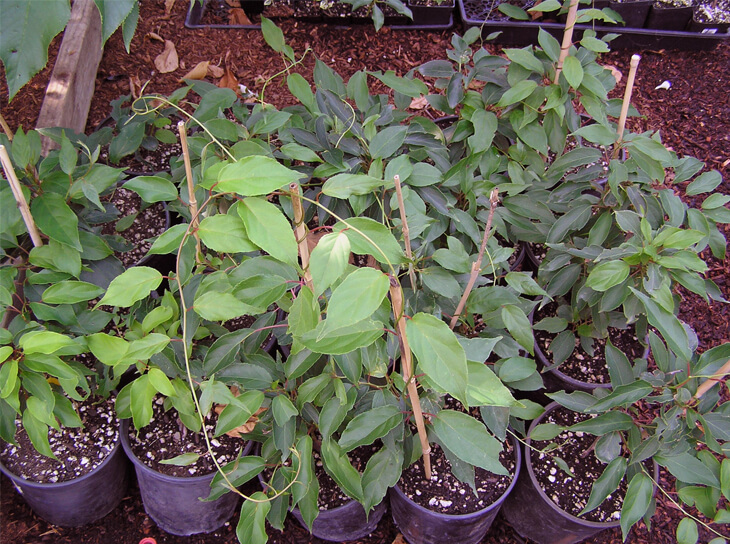
One gallon plants of the female variety ready for shipment. Packing Plants For ShippingMost of our plants are shipped bare root while they are dormant from late November through April and ship via the U.S. Postal Service. Bamboo plants can be shipped in their containers year-round by UPS.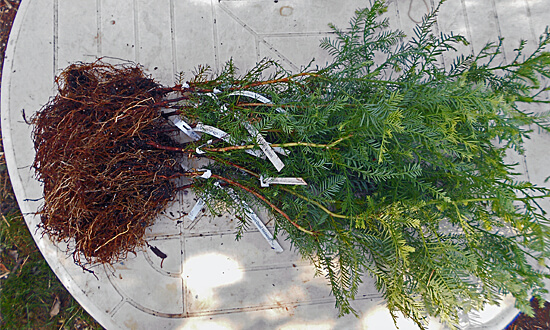 Bare root plants are soaked and wrapped together in bundles. ictured are 10x 24 inch tall Coast Redwoods. 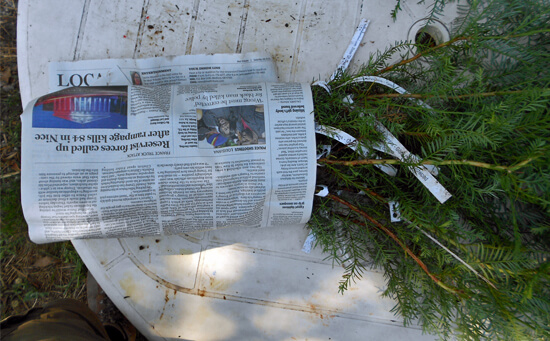 The bundled plants are wrapped in paper and labeled by variety. 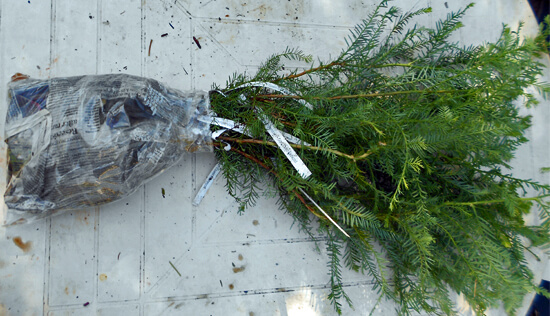 The bundle is wetted and bagged. 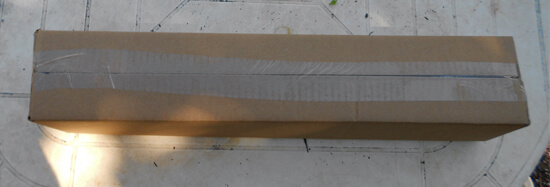 Bundles of plants are secured in long boxes. Pruning and Plant SizesWe prune both the tops and the roots of our plants at least once per year while they are growing in our nursery to ensure they develop a strong, dense form. Regular annual pruning goes a long way to ensure a healthy branching structure and this is often a missed step in many nurseries. Pruning a plant back hard after it has been neglected pruning-wise often results in an irregular branch habit or multiple leaders so we prune early and regularly instead. We also prune the roots of our plants while they are dormant which causes them to produce a much more branched structure and helps to elimate tangled masses that hinder future development. Plants that have been root pruned establish themselves much more quickly than root bound plants. Generally, hardwood plants will be pruned in the winter and conifers will be pruned in the summer.Before shipping plants we prune the tops and roots one last time. Conifers will usually have very little pruning except to balance out long branches. Shrubs are usually pruned to around 1-2 feet tall to encourage low branch development and small to medium sized trees are usually pruned to around 36-40 inches. Pruning trees at this height encourages dominant branches to begin forming around 3 feet from the ground which typically looks the best in most situations. However, if you want a tree to have branching start higher (some city codes require trees to not branch below 4 feet) we have longer boxes available. To request taller trees please contact us at least three days before your ship date. Depending on your location and the shipping routes there may be a fee for oversize package handling (usually about $15 for a 60 inch box). 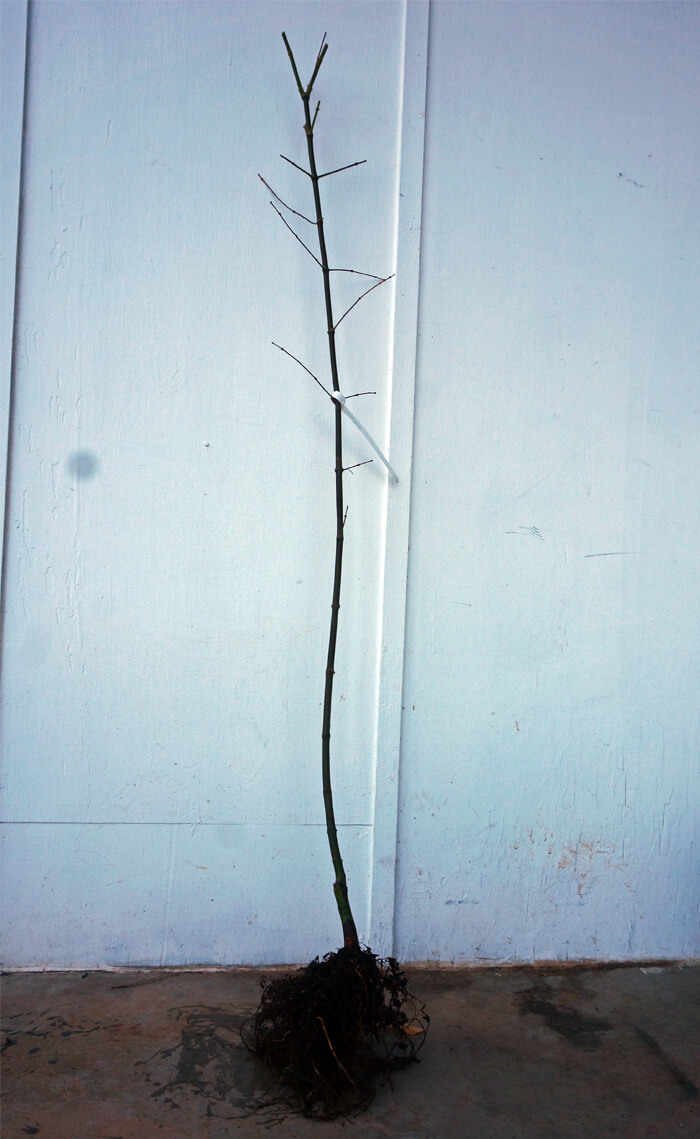 Tall trees (Oaks, Ginkgo, large Maples, etc.) are pruned to 40 inches to encourage crown development from about 36 inches and up 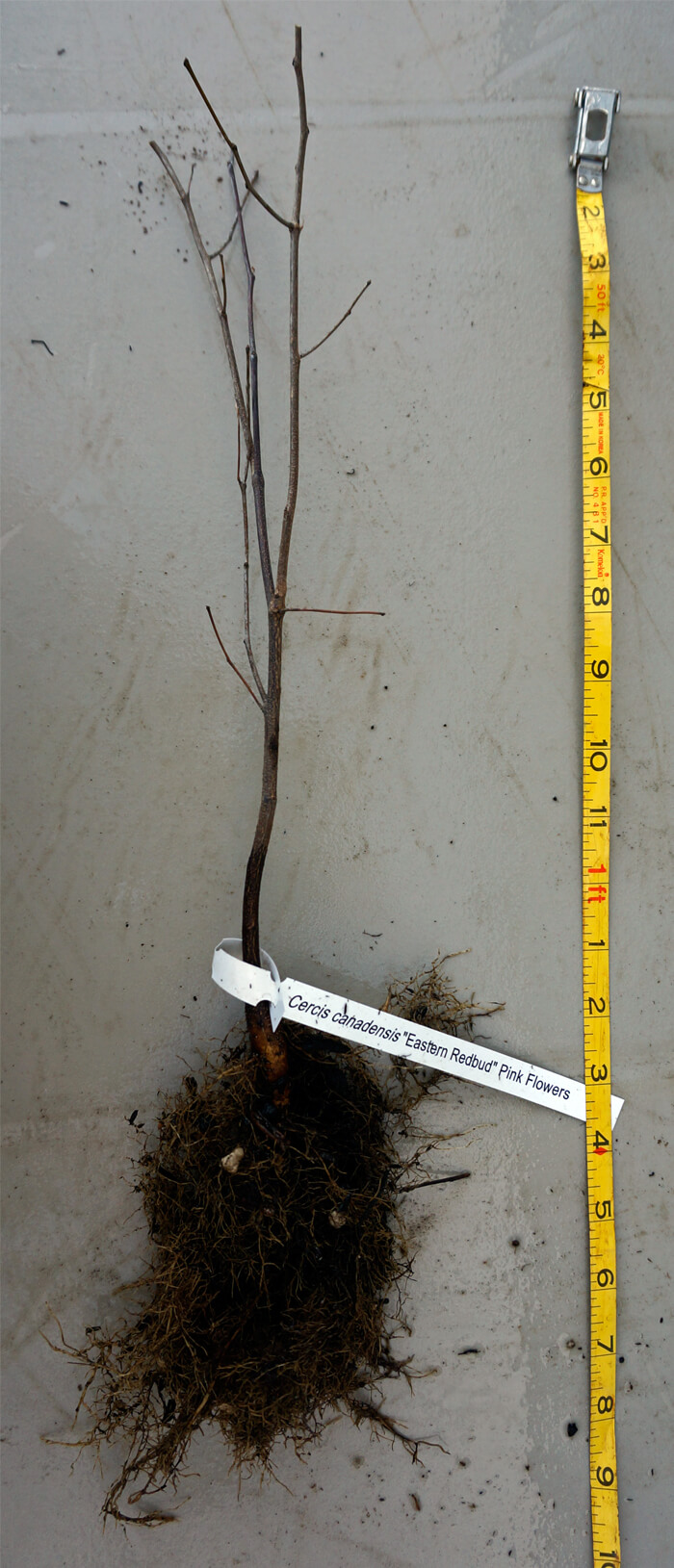 Small and medium trees (short Maples, Redbuds, Stewartia, etc.) are pruned 10-20 inches above the prune line from last year 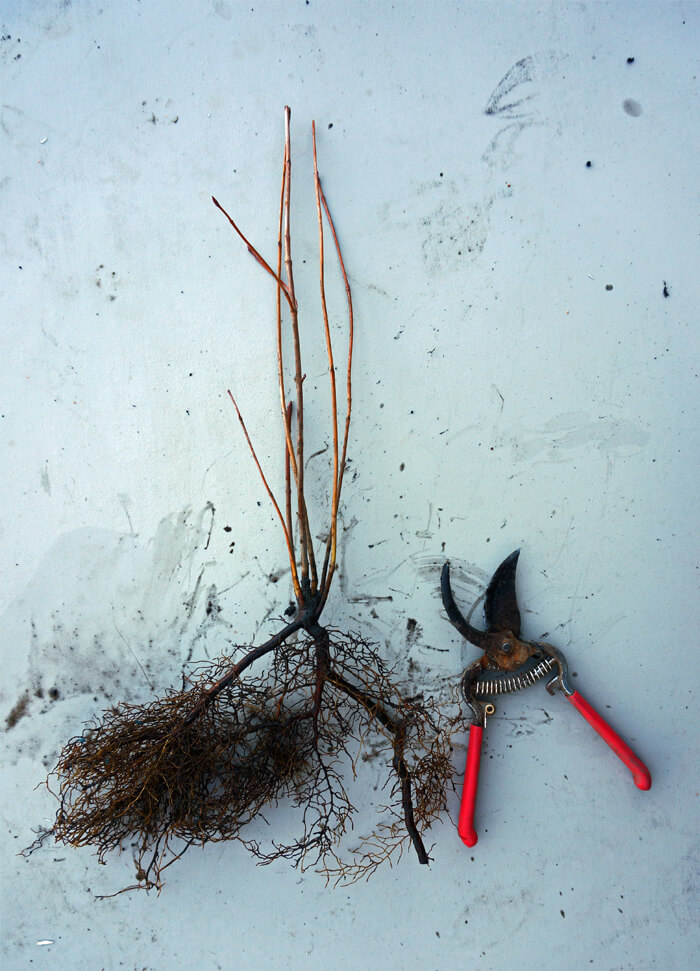 Shrubs (Weigela, Hydrangea, Viburnum, etc.) are pruned to 18 inches tall and root pruned one last time 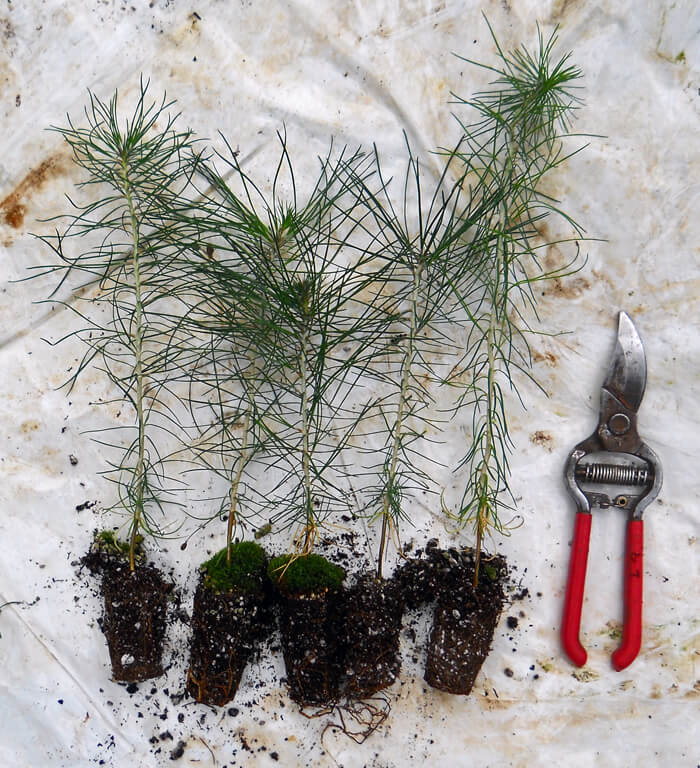 Small plug size Bamboo Plants Are Shipped In Their ContainersBamboo roots are not flexible and so plants have to be shipped in their containers. These plants are heavier and are shipped separately from bare root plants. Because they are potted they can handle longer transit times so can ship via UPS Ground instead of USPS Air Mail. Potted plants can also be shipped year-round.We regularly top our 1 gallon bamboo plants at 24-30 inches tall throughout the growing season. This results in dense, bushy foliage while allowing for economical shipping. From this size most running species will grow to 5-6 feet tall in the first spring and clumping species will usually grow to 4-5 feet tall.  1 gallon bamboo plants strapped in and ready to be sealed. Unpacking Bare Root PlantsYou will be sent tracking details as soon as your plants are shipped. Unpack your plants as quickly as possible after they are delivered. We use two types of boxes, side-sealing and top-sealing. For boxes that are taped along the whole length you can cut the tape on either side and remove the plant bundles by cutting the tape holding the bundle to the bottom. For boxes that are sealed on the top and bottom, it is easiet to open the bottom of the box (the shipping label is at the top) and pull the bundle of plants out straight out. Check that the box is empty as there can be a second bundle of plants stuck towards the top.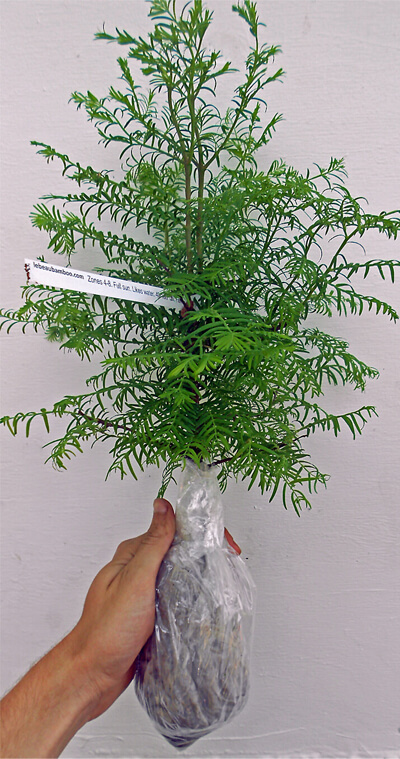 A bundle of trees. What if I am not able to plant right away?You can usually leave the plants in their shipping container unopened for 1-2 days if there were no shipping delays and you have received your plants from late November through February. Plants shipped when it is warmer can't stay in their packages for as long. |
Size Availability
Out of season.
Our main crop of most plants is available starting in late fall.
Additional batches of plugs and quarts are usually added in May.
Many of our plants are propagated in limited quantities and can sell out quickly when posted, get on the notification list below so you don't miss out. Add your email to be notified as soon as we have them back in stock:
This does NOT subscribe your email to any mailing lists, our system will only send an inventory notification message.
|



